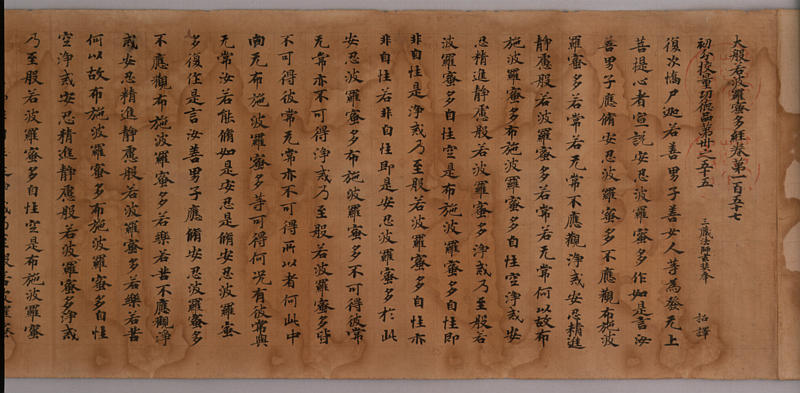大般若経巻第一五七(薬師寺経)
- 奈良時代
- 8c
- 紙本墨書
- H-1080 W-27.5
- 所蔵
- 薬師寺伝来
奈良時代後期を代表する古写経の一つで重量感あふれる筆致が素晴らしく、力強く肉太で大きめの字姿を持つ。この経典は大般若経六百巻の内の一巻であり、薬師寺に伝来したことから薬師寺経と呼ばれ、又、朝野宿禰魚養が書写したと伝えられるところから、魚養経とも呼ばれる。
奈良時代後期を代表する古写経の一つで、「薬師寺経」または「魚養経」と通称されてたいへん名高い「大般若経」600巻のうちの1巻である。
「大般若経」は、唐の玄奘が翻訳した経典で1部600巻からなり、その字数は約500万字といわれる仏典中最大のボリュームを誇る経典である。1部600巻を書写するのに必要な料紙の枚数は、約1万500枚を数える。
この「薬師寺経」は、奈良の薬師寺に伝来したのでその名があり、それらの巻首首題のところには「薬師寺印」の朱円印が2顆、第1紙紙背の表紙に近いところには「薬師寺金堂」の黒印が1顆捺されている。また「魚養経」については、8世紀後半の能書家として知られる朝野宿禰(すくね)魚養が書写したと伝えられるところからその名がある。
本文の重量感あふれる筆致が素晴らしく、謹厳で力強い筆致と肉太でやや大きめの字すがたは、奈良時代後期の写経の典型的な特徴を備えている。料紙は厚手の褐麻紙と見られ、経文は1行17字、1紙には24行が書写されている。
現在、「薬師寺経」の大部分にあたる378巻が国宝に指定されて大阪の藤田美術館に所蔵されているが、残念ながら、それらのいずれの巻にも書写年代を示す奥書は見当たらない。しかし、それらの中には巻末の軸付紙部分に紙数や本文の校正に関する墨書、さらには写経所の校生(書写された経文の正誤を点検する係)の名が見られるものがあり、これらを正倉院文書に照らしてみると、その書写が宝亀元年(770)頃に写経所で行われたことが判明する。
これらが寺外に流出したのは明治になってからであるが、もとの薬師寺には現在、重要文化財に指定されている37巻が伝えられている。藤田美術館と薬師寺以外には、50巻余りが巷間に分蔵されているものと思われる。
Catalogue Entry
Nara period, 8th century
Handscroll, ink on paper
H. 27.2 cm, Overall length: 1,051.0 cm
This is one scroll of the 600 scrolls of the Daihannya sutra version extremely well known by its popular names, the Yakushiji Sutra or Nagahi Sutra. This set of scrolls is one of the representative examples of old sutra copies from the late Nara period.
The Daihannya sutra (S: Maha prajnaparamita sutra) is a sutra text translated by Hsuan-tsang of the Tang dynasty and consists of a set of 600 scrolls. The Daihannya sutra is considered the longest sutra in the Buddhist canon and is approximately 5 million characters in length. It is thought that approximately 10,500 sheets of paper were needed to copy out the entire sutra.
This Yakushiji Sutra is named after Yakushiji in which the sutra has been preserved, and two round, red letter seals reading Yakushiji-in are impressed at the title at the beginning of each scroll, and a black ink seal reading Yakushiji Kondo is impressed on the back of the first sheet of paper on the mount sheet. The name Nagahi Sutra derives from the traditional attribution of the calligraphy to Asano Sukune Nagahi, famous as a talented calligrapher from the second half of the 8th century.
The brushwork in the sutra text itself is weighty and beautifully drawn, with the solemn, powerful brushstrokes, and fleshy, rather large characters fully representative of the typical style of sutra texts from the late Nara period. The material is a thick brown hemp paper, and the sutra is written out in lines of 17 characters, with 24 lines inscribed on each sheet of paper.
At present the majority of the Yakushiji Sutras, 387 scrolls, have been designated as National Treasures and are in the collection of the Fujita Museum, Osaka. Unfortunately, however, all of these scrolls lack the colophon information which would identify the date of their production. There is, however, writing in black ink on the paper attached to the roller bar at the end of some of the scrolls which notes the number of sheets of paper used, corrections to thserved in the Fujita Museum and Yakushiji, some fifty or so scrolls are thought to exist in various other collections.
